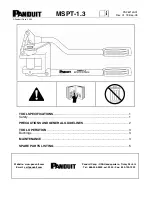
RK6040 60-ton Crimping Tool
Greenlee / A Textron Company
4455 Boeing Dr. • Rockford, IL 61109-2988 USA • 815-397-7070
6
Setup
Do not use this crimping tool with any hydraulic
hoses or other hydraulic components rated at less
than 700 bar (10,000 psi).
Failure to observe this warning will result in severe
injury or death.
Skin injection hazard:
Do not use hands to check for
•
leaks.
Depressurize the hydraulic system
•
before servicing.
Oil under pressure easily punctures
skin causing serious injury, gangrene
or death. If you are injured by
escaping oil, seek medical attention
immediately.
Wear eye protection when using this
tool.
Failure to wear eye protection could
result in serious eye injury from flying
debris or hydraulic oil.
Use proper die, connector, and wire combinations.
Mismatched components can result in an incomplete
crimp. Failure to complete a crimp could result in
severe injury, death, or fire if a connection separates
or if it has high electrical resistance.
Inspect tool and dies before use. Replace any worn
or damaged parts. A damaged or improperly assem-
bled tool can break and strike nearby personnel with
sufficient force to cause severe injury or death.
Do not operate crimping tool without dies in place.
Damage to the ram or crimping tool head may result.
Follow the operating instructions and safety informa-
tion supplied with the hydraulic power source.
1. Select the die set that corresponds to the size, type,
and manufacturer of connector to be crimped.
2. Press the release button on the ram and slide one of
the die halves into the jaw. Release the button and
slide the die half until the retainer snaps and locks
the die into place.
Press the die release button on the cap and slide
the other die half in. Release the button and slide
the die until the retainer snaps and locks into place.
3. Connect the hydraulic hose from the power source
to the tool.
4. In cold weather, allow the power source to run
(idle) for a few minutes to warm the hydraulic fluid.
Actuating the tool intermittently will reduce the time
required to warm the fluid to an efficient operating
temperature.




























